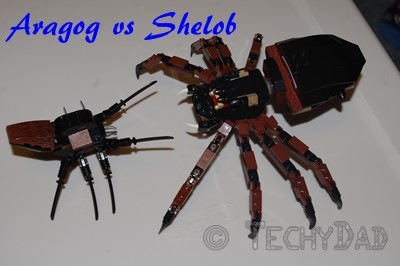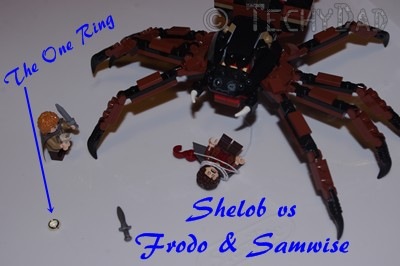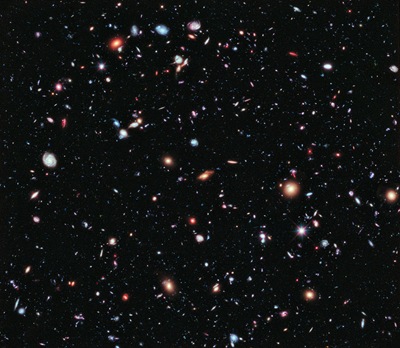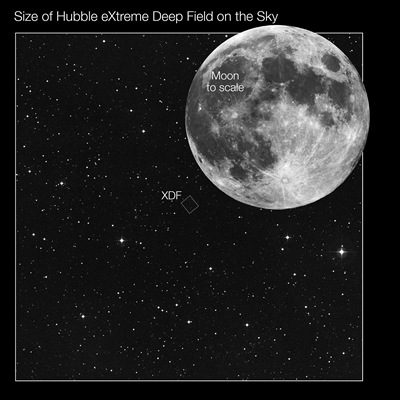Category: Geeky Pursuits
The Lonely Universe
I’m a big science fiction fan. A staple of science fiction is alien civilizations making contact with humans. Of course, we’ve yet to actually make contact or even find non-intelligent life out there. This isn’t to say that we haven’t looked. We have. We have detected planets outside of our solar system. We have even sent probes to other planets within our solar system. So why haven’t we found alien life? Perhaps it is just that the Universe is a big place.
The following is an image that the Hubble Space Telescope took of a tiny fragment of the sky.
Just how tiny? Well, this box shows the segment of the sky involved next to the moon.
That first image shows a lot of galaxies. Over 5,500, actually. In the entire Universe, there are 100 billion galaxies. Each galaxy has billions of stars. If only one hundredth of one percent had planets and only one hundredth of one percent of those had life and only one hundredth of one percent of those had intelligent life, there would be millions of intelligent life forms out there. So where are they? Why haven’t we heard any alien signals by now? Why haven’t the aliens heard our signals?
My personal theory is that time, language, and distance are the main factors. As I discussed previously, stars are very far apart from one another. We’ve only been sending signals into space that alien civilizations could detect for under 80 years. Already, we’re transitioning to technologies that might be harder for a hypothetical alien to detect. For example, we’re moving towards television transmitted via a wired Internet connection instead of via a TV tower that blasts the signal in all directions (including into space). As we do this, there will be less and less for aliens to detect.
Perhaps civilizations send out a blast of detectable signal before vanishing behind wired connections. If so, time works against us (and our hypothetical little green friends) in another fashion. When the alien signals pass us by, are we able to detect them? Perhaps the alien version of daytime TV was flooding past our planet, right there for anyone to pick up, but we were stuck in the Dark Ages. Maybe, while we were frightened of demons in the dark, proof of alien life was passing right in front of us. Possibly, a similar thing will happen with us. When old I Love Lucy broadcasts transmit past a planet with alien life, will the aliens be technologically savvy enough to detect it?
That brings us to the second point: Language. Specifically, would we recognize a signal as alien as opposed to gibberish. Suppose you didn’t understand Russian at all. If you heard five recordings, four with nonsense words and one of someone speaking Russian, it might be tough to pick out the real language. Now give that language an alien origin and see how you do. Now compress that signal using a method devised by aliens and would you even be able to tell that it wasn’t background noise?
Finally, we get to distance. Like I said earlier, there’s a huge distance between the stars. There’s an even bigger distance between galaxies. Perhaps aliens are out there all around us, but we can’t see or hear them because they are so far away. If an alien was in the Andromeda Galaxy, one of the nearest galaxies to ours, they would be over 2.5 million light years from us. This means that a message sent from them would take over 2.5 million years to reach us.
Science Fiction supposes a way to travel and communicate faster than light, but suppose science fiction is wrong. Suppose that the speed of light is the ultimate speed limit in the Universe. There could be millions of alien civilizations out there, all looking up at the stars and asking the same question: "Is anyone out there? Are we alone in the Universe?"
NOTE: The Hubble images come from here and here. Both images are free for anyone to use as are many other wonderful images from the Hubble Space Telescope.
Aloha Friday: Build or Buy – The Sonic Screwdriver Conundrum
 Recently, I’ve gotten interested in Doctor Who. I’ve been watching the episodes back to back to back on Netflix. It’s become a bit of an addiction for me. I’ll be sitting on the couch trying to get some work done and the Roku remote will start calling "Dooooctor Whoooo! Doooctor Whooo! Watch another episode of Doctor Who!" (I should probably call it a night when my electronics start talking to me.)
Recently, I’ve gotten interested in Doctor Who. I’ve been watching the episodes back to back to back on Netflix. It’s become a bit of an addiction for me. I’ll be sitting on the couch trying to get some work done and the Roku remote will start calling "Dooooctor Whoooo! Doooctor Whooo! Watch another episode of Doctor Who!" (I should probably call it a night when my electronics start talking to me.)
Since I love the show so much, and since I’m such a geek, I wanted to get some Doctor Who merchandise. Luckily, ThinkGeek has plenty of Doctor Who items to choose from. My favorite are the sonic screwdrivers.
For those who don’t watch Doctor Who, the Doctor isn’t one to brandish a gun and blast his enemies away. He’s more likely to outthink them. His tool of choice is a very special screwdriver that’s totally sonic. It can open nearly any door and can override computer systems. It’s the Swiss army knife of the Time Lords.
Of course, the sonic screwdrivers you can buy don’t really work like the Doctor’s. Most of them are flashlights (a logical leap as the Doctor’s lights up when he uses it), but a couple are pens or even TV remotes. As I was looking through them, I began to wonder which one to get. Then a thought occurred to me: Why don’t I try making one myself?
I’ve long admired and envied geeks who build things. I always think I don’t have the knack for it, but honestly I’ve never really tried that hard. I’m not going to fool myself and think that my creation will fool people into thinking it’s the real thing, but maybe I could make my own passable sonic screwdriver.
I’m thinking I’d start with a pen, put some kind of metal tubing around it and add some embellishments around that to make it look less like like a tube-with-a-pen and more like a sonic screwdriver. If I’m really feeling ambitious, maybe I’ll figure out how to wire up an LED light so that my sonic screwdriver pen can light up.
Yes, buying it would be faster and easier (maybe cheaper as well) and yes, it would probably look nicer, but a handmade sonic screwdriver could be fun and even educational (for both me and my boys).
My Aloha Friday question for today is: Do you usually "build" your own items or buy them? If you usually build, any advice you can give for where to go or how to approach this project would be appreciated.
P.S. If you haven’t already, try out my Twitter applications: FollowerHQ and Rout.
Disclaimer: The "build vs buy" image above was composed of "Tools, Hammer, Spanner" by Andy and "Money – banknotes and coin" by n_kamil. Both images are available through OpenClipArt.org.
Thanks to Kailani at An Island Life for starting this fun for Friday. Please be sure to head over to her blog to say hello and sign the linky there if you are participating.
Aloha #156
As Many People As Stars In The Sky
Every so often, I see something that makes me geek out a bit… or a lot. Most times, the "geek out" can be cured with a tweet or two, but sometimes 140 characters isn’t nearly enough. Sometimes I need a whole blog post.
Today’s Geek Out was inspired by a tweet by Phil Plait, aka BadAstronomer:
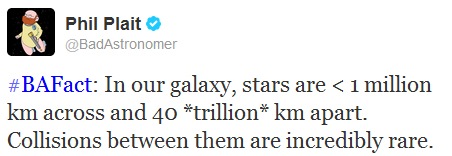
My first thought was: What if people were as spaced out (relative to our size) as stars are? Finding the average human height turns out to be a bit tricky. Different countries have different average heights. In addition, men and women tend to be different heights. Averaging the two figures (men and women) on this page gives me 66.6 inches. Of course, the rest of my figures are in metric, so let’s convert that. The average person is about 1.665 meters tall.
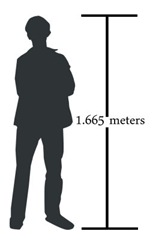
Now, Phil’s tweet indicated that a star’s "elbow room" was 40 million times it’s width (on average). Scaled down to human-sized figures, this would be 66,600 kilometers between each human. Arrange the people in a grid and they would each have a square foot area of 4,435,560,000 km (66,000 times 66,600) all to themselves.
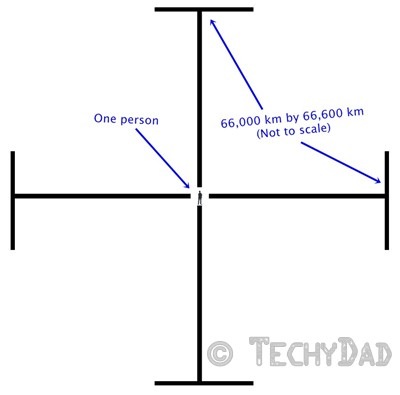
Now, we’ve run into a problem. The Earth has a surface area of about 510 million square kilometers. There simply isn’t enough square footage to separate two people on the entire planet Earth. In fact, the only planets whose surface area would be big enough to support two or more humans at "relative star distance" would be Jupiter (13 people) and Saturn (9 people). Uranus and Neptune would be only be able to support 1 person each and the other planets are simply too small.

Therefore, counting only planetary size and requiring at least 1 "relative star distance" per person, the solar system’s population would be a whopping 24.
Now, obviously, there isn’t a tiny amount of stars in existence. Thanks to the huge Universe (impossibly huge, unimaginably huge), there are a lot of stars in the sky.
There are somewhere between 100 and 400 billion stars in our galaxy and possibly as many as 100 billion galaxies. This means that there is somewhere around 10 sextillion stars in the known Universe. (For those keeping count, that’s 10,000,000,000,000,000,000,000 stars.) The biblical pledge to "make your descendants as numerous as the stars in the sky" was really saying something. One hopes that we’ve invented space travel by then, because that would be one crowded Earth.
But how crowded? If we magically increased the world population to 10 sextillion right now, how much space would you and I have to live on? To make things simple, we’ll also magically make every square inch of the Earth able to house a human being. Even the oceans and mountains would be fair game.
With 10 sextillion people and a surface area of the Earth as specified above, each person would have to occupy an area about half of a square nanometer. To put this in perspective, this is slightly less than the width of a Uranium nucleus. Talk about a tight fit!
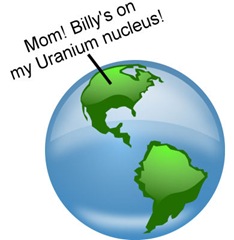
What about Jupiter, though. Surely, if we all moved to the Solar System’s biggest planet (and could somehow withstand the gravity), we would have room to spread out, right? Sadly, Jupiter "only" has a surface area of about 61,400,000,000 square km. Even a helium atom’s width would be too much.
So let’s move to the sun. If we can magically make 10 sextillion people appear, we can also magically keep them from incinerating (or getting crushed by gravity or suffocating from lack of air) as they move onto the Sun’s surface. Even that would be too tiny: Two carbon atoms’ width per person. This "as numerous as the stars in the sky" thing is starting to sound more like a curse than a blessing!
Thank you for indulging me in my little geek-out. Hopefully, I was able to translate just how many stars are in the Universe and how spread out they are in space.
Disclaimer: The person silhouette image is by rejon on OpenClipArt.org. The images of Jupiter, Saturn, Uranus, and Neptune were obtained from Wikipedia (links to each on each of the planets’ names) but are public domain images taken by NASA. Finally, the "glossy globe" image is by freedo on OpenClipArt.org.
Aloha Friday: Time Travel Destinations
 Time Travel has been a hot topic this summer. First, NHL and I watched the Back To The Future trilogy. He marveled at the exploits of Doc Brown and Marty McFly through various time periods. Then, more recently, we finished Harry Potter and the Prisoner of Azkaban where time travel factors in heavily. (Time travelling wizards!)
Time Travel has been a hot topic this summer. First, NHL and I watched the Back To The Future trilogy. He marveled at the exploits of Doc Brown and Marty McFly through various time periods. Then, more recently, we finished Harry Potter and the Prisoner of Azkaban where time travel factors in heavily. (Time travelling wizards!)
The big recent time travel introduction, though, has been my introduction to the world of Doctor Who. I had put it on my Netflix Instant Queue a long time ago and kept meaning to watch it. Last week, I finally took the plunge. I’ve been addicted ever since.
For those who don’t know, Doctor Who is the story of a time travelling alien known only as The Doctor. He’s the last of his race, the Time Lords. He travels through time and space with one or more companions. Along the way, he inevitably runs into danger which he overcomes using mainly his wit and intellect.
My Aloha Friday question for today is: If you could travel to any place in the future or past, where would you go and why?
P.S. If you haven’t already, try out my Twitter applications: FollowerHQ and Rout.
Disclaimer: The "Earth Time" image is a combination of Glossy Globe by Freedo and Clock by Palomaironique, both of which are from OpenClipArt.org.
Thanks to Kailani at An Island Life for starting this fun for Friday. Please be sure to head over to her blog to say hello and sign the linky there if you are participating.
Aloha #154




